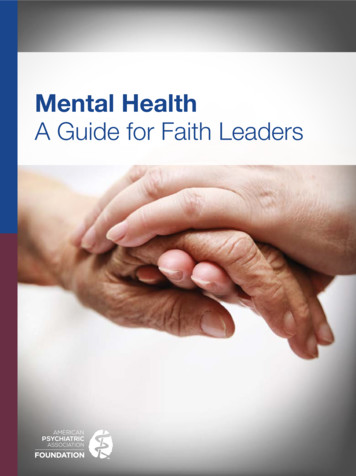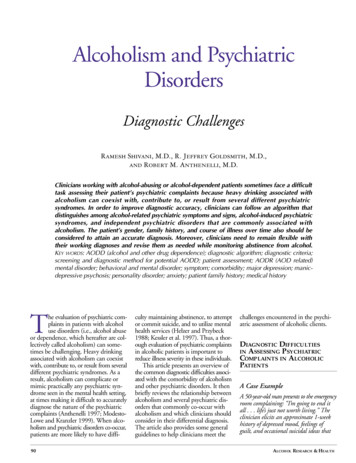American Psychiatric Association AND American
American Psychiatric AssociationANDAmerican Telemedicine AssociationBest Practices In Videoconferencingbased Telemental Health 2018 American Psychiatric Association. All rights reserved.
WRITING COMMITTEE: 2Jay H. Shore, MD, MPHPeter Yellowlees MD, MBBSRobert Caudill, MDBarbara Johnston MSNTurvey Carolyn, PhDMatthew Mishkind, PhDElizabeth Krupinski, PhDKathleen Myers, MD, MPHPeter Shore PhDEdward Kaftarian, MDDonald Hilty, MD
STAFF SUPPORT: Sabrina L. Smith (ATA), DrHA Harry Mellon (ATA) Nathan Tatro (APA) MA, Michelle Dirst (APA)REVIEWERS: 3Telemental Health Special Interest Group [ATA]APA Telepsychiatry Committee (APA),ATA Standards and Guidelines Committee Member [SG]ATA Staff [ATAS]APA Staff (APAS)
INTRODUCTION Collaboration between the American Psychiatric Association (APA) andthe American Telemedicine Association (ATA). The ATA is the principal organization bringing together telemedicinepractitioners, healthcare institutions, government agencies, vendorsand others involved in providing remote healthcare usingtelecommunications.4 2018 American Psychiatric Association. All rights reserved.
INTRODUCTION These guidelines focus on interactive videoconferencing based mentalhealth services (a.k.a., telemental health). The use of othertechnologies such as virtual reality, electronic mail, electronic healthrecords, telephony, remote monitoring devices, chat rooms, or socialnetworks are not a focus of this document except where thesetechnologies interface with videoconferencing services.5 2018 American Psychiatric Association. All rights reserved.
OFFICIAL APA AND ATA GUIDELINES, RESOURCESAND TELEMENTAL HEALTH TRAININGSAPA1. APA Web-based TelepsychiatryToolkit (2016)2. Resource Document onTelepsychiatry and RelatedTechnologies in ClinicalPsychiatry, Council on Law andPsychiatry (2014)3. American PsychiatricAssociation. Telepsychiatry viaVideoconferencing. (1998)6ATA1. Practice Guidelines for TelementalHealth with Children and Adolescents(2017)2. Online Training for Video-BasedOnline Mental Health Service (2014)3. A Lexicon of Assessment andOutcome Measures for Telementalhealth (2013)4. Practice Guidelines for Video-BasedOnline Mental Health Service (2013)5. Practice Guidelines forVideoconferencing-Based TelementalHealth (2009)6. Evidence-Based Practice forTelemental Health (2009) 2018 American Psychiatric Association. All rights reserved.
GUIDELINES FRAMEWORK Administrative– Organization SOPs & responsibilities– Health professional SOPs & responsibilities Clinical– Not how to practice, diagnose etc.– How to conduct traditional practice in the context of THencounter Technical– Devices & equipment– Security & privacy– Minimum technical standards7
ADMINISTRATIVE AND REGULATORY ISSUES IN TELEPSYCHIATRY Regulatory MalpracticeLicensureStandard of CareRyan Haight/Prescribing Administrative Protocols and procedures Workflow Economic models (Billing and re-imbursement)8 2018 American Psychiatric Association. All rights reserved.
ADMINISTRATIVE CONSIDERATIONSSTANDARD OPERATING PROCEDURES/PROTOCOLS Prior to initiating telemental health services, any organization orprovider shall have in place a set of Standard Operating Procedures orProtocols that should include (but are not limited to) the followingadministrative, clinical, and technical specifications:– Roles, responsibilities (i.e., daytime and after-hours coverage),communication, and procedures around emergency issues.– Agreements to assure licensing, credentialing, training, andauthentication of practitioners as well as identity authentication ofpatients according to local, state, and national requirements.– A systematic quality improvement and performance management processthat complies with any organizational, regulatory, or accrediting,requirements for outcomes management.9 2018 American Psychiatric Association. All rights reserved.
SPECIAL ISSUES REGARDING CONTROLLED SUBSTANCES– Controlled and non-controlled substances Definitions of controlled substances.– Federal Law vs. State law.– Ryan Haight Act History Practice effects Special registration developments Impact of MAT on electronic prescribing and telemedicinepractice.10 2018 American Psychiatric Association. All rights reserved.
ADMINISTRATIVE– Protocols and procedures– Workflow– Economic models (Billing and reimbursement)11 2018 American Psychiatric Association. All rights reserved.
ADMINISTRATIVE - PROTOCOLS AND PROCEDURES 12Practice Guidelines For Video-Based Online Mental Health Services(May 2013), American Telemedicine AssociationPractice Guidelines for Videoconferencing-Based Telemental Health(October 2009) American Telemedicine AssociationEvidence-Based Practice for Telemental Health (July 2009),American Telemedicine AssociationPractice Parameter for Telepsychiatry With Children andAdolescents (December 2008), American Academy of Child andAdolescent PsychiatryKrupinski EA, Bernard J. Standards and Guidelines in Telemedicineand Telehealth. Healthcare 2014,2,74-93. 2018 American Psychiatric Association. All rights reserved.
ADMINISTRATIVE - WORKFLOW Evolving– Clinical vs. non-clinical settings Modifications to treatment as usual Adjunctive technologies and personnel– Secure Communications with scheduling– Electronic prescribing/EPCS– Use of telefacilitators?13 2018 American Psychiatric Association. All rights reserved.
ADMINISTRATIVEECONOMIC MODELS (BILLING AND REIMBURSEMENT) 14Fee for service (concierge model vs. third party)Contract (institution to institution)RetainerImpact of DTC service delivery. 2018 American Psychiatric Association. All rights reserved.
MANAGING HYBRID PATIENT-PROVIDER RELATIONSHIPS Hybrid relationship managed across range of settings in-person,telehealth and technologies (eg. Videoconferencing, email, phone) Clear education and boundaries with patient of how and when tocommunicate and over which technologies Attention to rapport, trust and comfort of patient with eachcommunication Checking in on how patient is doing with regards to communicationrelationship Checking and clarifying for miscommunication andmisunderstandings15 2018 American Psychiatric Association. All rights reserved.
HOW IN-HOME TELEHEALTH DIFFERS FROM IN-CLINIC Environmental scan in home– Appropriateness (safety and confidentiality during session)– Information on patient (organization, style, function, lifestyle) Active Management of image and environment with patient Awareness of any safety issues or concerns16 2018 American Psychiatric Association. All rights reserved.
TELE-TEAMINGTeam communication– Ground rules for communication (mediums, timingand setting)– In-person visits/team bonding– Importance of over communication undercommunication especially in beginning of services– Definitions of roles and specifically at interface onpatient communication/contact Team Building– Recognition that Team building and communication is responsibility of all teammembers– Seeking clarifications across team– Shared cultural and processes– Tolerance of difference in perspectives and backgrounds17 2018 American Psychiatric Association. All rights reserved.
TECHNICAL REQUIREMENTS: Videoconferencing Platform Requirements Integration of VTC into other technology andsystems– Privacy, Security, HIPAA Physical Location/Room Requirents– Privacy– Camera placement– Comments on asynchronous set ups.18 2018 American Psychiatric Association. All rights reserved.
KEY REFERENCESFoundational Documents APA Web-based Telemental health Toolkit ctice/telemental health Recupero, P., & Fisher, J. C. E. (2014). Resource Document on Telemental health and Related Technologies inClinical Psychiatry. American Psychiatric Association. Telemental health via Videoconferencing. (1998) Myers, K., Nelson, E. L., Rabinowitz, T., Hilty, D., Baker, D., Barnwell, S. S.,. & Comer, J. S. (2017). AmericanTelemedicine Association Practice Guidelines for Telemental Health with Children and Adolescents.Telemedicine and e-Health. Turvey C, Yellowlees P, Shore JH, Shore P. Delivering Online Video Based Mental Health Services. AmericanTelemedicine Association Learning Center, og/item/id/241193;jsessionid 811FB256406248FFC1A45D3835DF3A99.worker1) Turvey C, Coleman M, Dennison O, Drude K, Goldenson M, Hirsch P, Jueneman R, Kramer GM, Luxton DD,Maheu MM, Malik TS, Mishkind MC, Rabinowitz T, Roberts LJ, Sheeran T, Shore JH, Shore P, van Heeswyk F,Wregglesworth B, Yellowlees P, Zucker ML, Krupinski EA, Bernard J.(2013). ATA practice guidelines for videobased online mental health services. Telemedicine Journal and E Health, 19(9),722-30. doi:10.1089/tmj.2013.9989 American Telemedicine Association. (2013). Practice guidelines for video-based online mental healthservices. Washington, DC, USA. Yellowlees, P., Shore, J., & Roberts, L. (2010). Practice guidelines for videoconferencing-based telementalhealth–October 2009. Telemedicine and e-Health, 16(10), 1074-1089. Grady, B., Myers, K. M., Nelson, E. L., Belz, N., Bennett, L., Carnahan, L., . & Rowe, N. (2011). Evidencebased practice for telemental health. Telemedicine and e-Health, 17(2), 131-148.19 2018 American Psychiatric Association. All rights reserved.
KEY REFERENCESKey Reviews and Updates Hubley, S., Lynch, S. B., Schneck, C., Thomas, M., & Shore, J. (2016).Review of key telemental health outcomes. World journal ofpsychiatry, 6(2), 269. Bashshur, R. L., Shannon, G. W., Bashshur, N., & Yellowlees, P. M.(2016). The empirical evidence for telemedicine interventions inmental disorders. Telemedicine and e-Health, 22(2), 87-113. Hilty, D. M., Ferrer, D. C., Parish, M. B., Johnston, B., Callahan, E. J., &Yellowlees, P. M. (2013). The effectiveness of telemental health.Telemedicine and e-Health, 19(6), 444-454 Shore, J. H. (2013). Telemental health: videoconferencing in thedelivery of psychiatric care. American Journal of Psychiatry, 170(3),256-262.20 2018 American Psychiatric Association. All rights reserved.
communication, and procedures around emergency issues. –Agreements to assure licensing, credentialing, training, and . Telemedicine Association Practice Guidelines for Telemental Health with Children and Adolescents. Telemedicine and e-Health. Turvey C, Yellowlees P, Shore JH, Shore P
American Psychiatric Association Foundation 1800 Maine Avenue, S.W., Suite 900, Washington, DC 20024 americanpsychiatricfoundation.org The correct citation for this book is American Psychiatric Association Foundation: Mental Health: A Guide for Faith Leaders. Arlington, VA, Am
Psychiatric and mental health nursing practice is having a significant impact on the health and recovery of service users. Psychiatric and mental health nursing research and theory is making substantial contributions when it comes to developing and managing the organization and delivery of health care. The study of psychiatric and mental health
Advanced Practice Registered Nurses (APRNs must be nurse practitioner specialists in adult psychiatric and mental health, and family psychiatric and mental health, or certified nurse specialists in psychosocial, gerontological psychiatric mental health, adult psychiatric and mental health and child- adolescent mental health and may
distinguishes among alcohol-related psychiatric symptoms and signs, alcohol-induced psychiatric syndromes, and independent psychiatric disorders that are commonly associated with alcoholism. The patient’s gender, famil
their families with actual or potential psychiatric mental health problems. 3. Apply advanced psychiatric mental health nursing services in the care of adults and their families representing diversity in cul ture, lifestyle, and values. 4. Make clinical decisions related to the psychiatric mental health care of adults and their families based on
Appendix B. Maryland State Health Plan Inpatient Acute Psychiatric Bed Need Methodology . 54 Appendix C. Inpatient Psychiatric Beds per 100,000 Residents. 55 Appendix D. A Note on Child and Adolescent Use of Psychiatric Hospital Inpatient Services, Suicide, and
Chapter 5.1 - Psychiatric Interview, History, and Mental Status Examination Chapter 5.2 - The Psychiatric Report and Medical Record Chapter 5.9 - Physical Examination of the Psychiatric Patient Chapter 6 - Classification in Psychiatry In addition to the above, students may wish to refer to Psychiatric Interviewing: The Art of
psychiatric/mental health nursing and complete two (2) years of supervised clinical experience in providing psychiatric/mental health counseling services. The master’s degree in nursing must be . directly related to mental health, such as psychiatric/mental health File Size: 676KB























